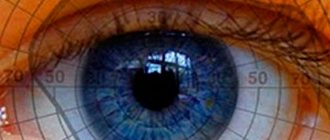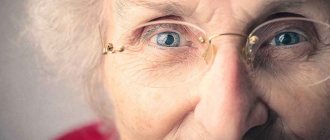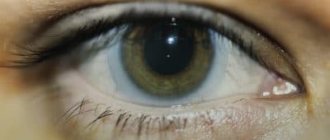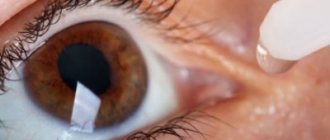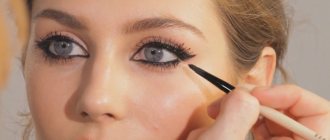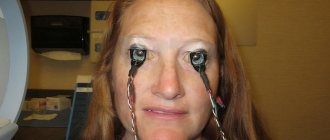The number of people suffering from visual impairments is increasing every year. This progress is associated with the stresses of modern life and myopia is a clear example of this.
According to health data, up to 30% of the world's inhabitants are diagnosed with myopia (of varying degrees). This means, on average, 3 out of 10 are myopic.
It is because of the refractive error that a picture up close is seen better than at a distance. To view an object, you need to hold it closer to your eyes, at arm's length. Among the people, myopia has a second, more popular name - myopia.
What it is?
Myopia (in translation from ancient Greek - “squinting the eyes”) is a vision defect in which the image is formed not on the retina, as is normal, but in front of it. Myopia is also often confused with accommodation spasm
With myopia, a person usually squints when looking at distant objects, as a fuzzy, blurry image appears on the retina of the eye.
Types of myopia
In ophthalmology, it is customary to classify myopia into the following types:
- Congenital myopia. It is rare and is caused by abnormalities in the development of the eyeball in the fetus.
- High myopia. This is a form of myopia whose degree exceeds 6.25 diopters.
- Combination myopia. It is characterized by a small degree of myopia, in which the refractive power of the optical system of the eye and the length of its optical axis are not combined, which reduces the refraction of vision.
- False myopia. It occurs when the tone of the ciliary muscle increases and disappears when the spasm passes.
- Transient myopia (a variant of false myopia). It can occur against the background of an underlying disease of the body (for example, diabetes) or as a result of taking certain medications.
- Night myopia. Appears when there is a lack of light and disappears when illumination increases.
- Axial myopia. Occurs when the optical axis of the eye is long.
- Complicated myopia. Accompanied by anatomical changes in the eye, which over time lead to loss of vision.
- Progressive myopia. It is characterized by a gradual increase in its degree due to stretching of the posterior part of the eye.
- Refractive (optical) myopia. Caused by excessive refraction of the optical system of the eye.
Degrees of myopia
Experts distinguish 3 degrees of myopia:
- weak (up to 3 diopters);
- average (from 3.25 to 6 diopters);
- high (over 6 diopters).
Myopia code according to ICD 10
Myopia is a disease in which a person’s visual acuity decreases due to the lack of focusing of rays on the retina. The standard ICD 10 myopathy code consists of the following characters: H52.1.
The disease is in the class of pathological processes of the eye and the section of disorders of the muscular layer, accommodation and refraction. Myopia is located in the category of diseases associated with improper functioning of accommodation and refraction. In everyday life, this pathology is called myopia, which means a deterioration in the vision of distant objects.
Additionally, the following diseases close to myopia are coded:
- malignant myopia;
- degenerative type of myopathy;
- endophthalmitis, accompanied by decreased visual acuity.
The myopathy code contains the necessary information about the etiological factors, pathogenesis, clinical picture, diagnosis and treatment of the pathological process. Thanks to the international classification of diseases, doctors anywhere in the world will be able to correctly diagnose and apply optimal principles of therapy, on which individual treatment protocols will be based.
The development of myopia is based on the incorrect operation of the optical lens of the eye apparatus, due to which the image is focused in front of the retina, and not on it.
Thus, a person sees objects blurry. This problem can be congenital, more often caused by abnormalities in the prenatal period or heredity. In acquired myopathy, the main role is played by the depletion of the optical apparatus due to visual overstrain. These changes are not always reversible, so replacement correction with specially selected lenses is recommended for people with myopia.
Also, the disease can have a stationary course (visual acuity remains stable), progressive (there is a gradual deterioration in clarity), transient (characterized by a secondary, temporary decrease in visual acuity).
Medical treatment protocols distinguish three types of therapeutic measures for myopia:
- Optical correction. Lenses or glasses are used, which are selected individually by the attending physician, taking into account all the characteristics of the patient’s body. As a rule, this therapy allows to slow down the progression of the pathology.
- Training and exercises. The treatment is suitable for patients with a mild degree of pathology, which developed as a result of overstrain of the eye apparatus, for example, due to computer work.
- Surgery. It is used in advanced situations when other methods are powerless. Patients undergo lens replacement or special lenses are implanted.
In ICD 10, myopathy is characterized as a dangerous pathology (starting from moderate severity), requiring certain restrictions in physical activity.
Rate this article
Myopia or myopia is one of the most common diseases in ophthalmology. The disease is diagnosed in both children and adults and is often inherited, affecting members of the same family from generation to generation.
According to the international classification of diseases, myopia has the following code: H52.1
The disease has several types of course, developing rapidly or slowly (depending on the type of course). Leads to severe complications and can cause complete blindness.
If the disease is not treated, it can lead to complete blindness.
The disease is associated with older people, elderly grandparents, but in fact, myopia is an ailment of the young; according to statistics, about 40-60% of school graduates suffer from it. And among children 6-7 years old, the incidence rate does not exceed 30-40%.
The disease is corrected with the help of glasses and lenses; they are recommended to be worn on an ongoing basis or used from time to time (depending on the type of myopia). But such a correction is not a cure for the disease; it only helps to correct the patient’s condition, and not to stop the progress of the disease.
Possible complications of myopia:
- Retinal disinsertion.
- Dystrophic changes in retinal vessels.
- A sharp decrease in visual acuity.
- Corneal detachment.
Prolonged and uncompensated course of the disease leads to severe complications, which even surgical intervention will not help get rid of.
Myopia can be successfully combined with other eye diseases, from astigmatism to retinal pathologies.
In most cases, myopia progresses slowly; a number of factors can provoke its sudden development:
- long-term stress on the organs of vision;
- disruption of blood flow to the brain;
- long periods of time at the computer (due to harmful radiation).
The reason for everything may be a person’s profession, his addiction to computer games, working with soapy objects, etc.
You can try to describe the world through the eyes of a person who has myopia. He sees a fuzzy, blurry picture. Its boundaries merge, which does not allow a person to accurately examine the image in detail.
This happens due to the fact that the “picture” is formed not on the retina, as it should be, but in front of it, which leads to a disruption in image perception. Less commonly diagnosed is strong refraction of rays that touch without reaching the retina.
The video shows a description of the disease:
A routine examination by an ophthalmologist will help diagnose the disease. It does not cause any difficulties, for this reason myopia is easily diagnosed in any case.
In addition to the examination, the doctor may recommend undergoing a number of additional examinations: ultrasound of the eyes, etc. (at the doctor’s discretion).
Symptoms of myopia include the following:
- Increased fatigue of the visual organs.
- Blurred image, decreased visual acuity.
- Inability to see a distant image.
- The appearance of “floaters” or glare before the eyes.
Initially, a person notices that he has difficulty seeing objects located at a certain distance from him. Up close, he sees clearly, can read inscriptions, books, and distinguishes small letters. But a lot depends on the degree of myopia. If it is high, then problems may also arise when reading small print.
The first thing you should pay attention to is the rapid fatigue of the organs of vision, while against the background of a similar factor, it is noted: the appearance of pain or pain in the eyes, a decrease in visual acuity, the appearance of “spots” or glare in front of the eyes.
Signs may be bothersome on an ongoing basis or appear from time to time (as with false myopia); with visual stress, the symptoms intensify, accompanied by headaches, dizziness, etc.
There is an extensive classification of myopia in ophthalmology, and there are degrees of development of this disease. If we talk about them, then myopia can be conditionally classified as:
- weak - with a decrease in vision to 3 diopters;
- medium - with a decrease in visual acuity to 6.25 diopters;
- high - with a decrease in visual acuity above 6.25 diopters.
In the early stages of the disease, correction is made with the help of glasses; in later stages, preference is given to contact lenses.
Myopia is classified by type, it can be:
- Congenital is a rare type, diagnosed in a child in the first year of life and progresses over time, dangerous due to complications and rapid development associated with the growth and development of the baby.
- False - characterized by the presence of temporary symptoms, symptoms appear only under certain circumstances, after which they disappear on their own, do not require specific treatment.
- Night myopia is another type of myopia; the symptoms only bother you at night; in normal lighting, a person sees well.
- Progressive - characterized by rapid development and most often leads to complications. In case of unfavorable development of events or in the absence of adequate therapy, it can cause blindness.
- Degenerative myopia is an eye disease with degenerative changes and a drop in visual acuity below 6 diopters. This type of disease most often leads to disability and severe complications.
- Refractive – caused by excessive refractive power of the optical axis of the eye.
- Complicated – accompanied by anatomical changes in the structure of the visual organs, which lead to a rapid decrease in visual acuity.
- Transient is a type of false myopia, which is often diagnosed in people with systemic diseases (diabetes mellitus) and can develop while taking certain medications.
This disease occurs in conjunction with other diseases - Malignant - characterized by rapid progress, leads to complications and can cause complete loss of vision.
The classification is very broad, but such a division helps to differentiate the disease and correctly select treatment for the patient.
There are several causes of occurrence; they can be conditionally divided into 2 groups: congenital and acquired.
If we talk about congenital causes of the disease, they are caused by a hereditary factor. That is, as such, the disease is not inherited, only the predisposition to it is transmitted.
But with a combination of unfavorable factors, myopia can “declare” itself. If it is diagnosed in a child, then there is a high probability that the progression of the disease will have a direct connection with the baby’s growth and development.
If we talk about acquired causes, they may have a connection:
- with systemic diseases;
- with age-related changes;
- with professional activities;
- with heavy loads on the organs of vision.
All this can be regarded as the cause of myopia. But this disease often occurs as a complication of another pathology that a person has. This could be diabetes, heart or vascular disease, impaired blood flow to the brain, etc.
The video shows the causes of the disease:
This issue is considered controversial, since nominally disability is given only to those people who have serious illnesses that lead to the inability to fully perform self-care.
There is a misconception that disability for myopia is given if it reaches a high degree, but this is not entirely true.
You can only count on receiving a pension:
- Patients with degenerative myopia.
- People with myopia, which has led to complications in the form of dystrophic or degenerative changes in the retina.
With a high degree of myopia and its rapid progress, the likelihood of becoming disabled is higher. But it all depends on the specific case. The decision is made by the commission, the general condition of the patient and his ability to perform self-care functions are assessed.
The commission will also evaluate the effectiveness of the therapy; if the treatment does not bring results over a long period of time, then the chances of becoming disabled are very high.
There are several treatment methods that are used for varying degrees of myopia. Therapy is carried out with the help of medications, the possibility of surgical intervention and other methods of correcting disturbances in the functioning of the visual organs is discussed.
It is used both as a treatment for the underlying disease and as a method of prevention. It involves the use of some kind of device with the help of which therapy will be carried out.
This treatment is most effective in children; it can be carried out using:
- magnet;
- laser;
- electrophoresis;
- vacuum simulators, etc.
The therapy acts as a complement to drug treatment using various drugs and vitamins. A set of procedures is developed individually, based on the patient’s condition.
As a rule, hardware treatment is successfully combined with eye exercises; for this reason, it is recommended to perform exercises for the organs of vision when carrying out such treatment.
The video shows the process of treating myopia:
It is most effective in the presence of false myopia, the cause of which is considered to be a spasm of the ciliary muscle. This type of disease is treated with drops; they help relieve spasm, but with prolonged use they can lead to an increase in intraocular pressure.
List of drugs:
- Tropicamide.
In order to establish normal eye pressure, this remedy is most often used. - Scopolamine.
For myopia, other medications are also used, we are talking about vitamins (for general strengthening of the body) and drugs that improve tissue permeability, these include:
- Rutin;
A complex product that should be used as prescribed by a doctor. - Trental;
- Sodium gluconate.
If necessary, the doctor can prescribe other medications; each case is considered individually, and therapy is supplemented with the necessary medications.
It involves surgical intervention, is performed using various methods, and is often combined with lens replacement or corneal transplantation.
So, the main types of surgical operations for myopia:
- PRK or photorefractive keratectomy.
- Laser correction using the LASIK method.
- Radial keratotomy and keratoplasty.
- Refractive lens replacement.
The video shows a description of the laser correction procedure using the lasik method:
Performing surgery is associated with certain risks; for this reason, operations are performed only when indicated, in order to stop the progression of the disease. It is worth noting that surgical interventions are rarely performed on children under 18 years of age, since their effectiveness is temporary, as the child’s body grows and develops.
Treatment of children is carried out using various methods; surgery is excluded and is performed only in severe cases.
When conducting therapy in young patients, it is permissible to:
- use of devices;
- use of medications;
- carrying out vitamin therapy.
Often, parents of a child with myopia have a question: can their child engage in physical education and sports?
Restrictions are imposed only on those children who have a high degree of myopia. For other children with moderate and weak myopia, sports and physical education will not do any harm. According to scientists, children with myopia often have other diseases, which (to a certain extent) can be compensated for by playing sports.
The question of how a woman with a high degree of myopia will give birth remains open. There are a number of absolute contraindications for which an ophthalmologist recommends a cesarean section, these include:
- Complications of myopia.
- Retinal detachment.
- A sharp decrease in visual acuity during pregnancy.
- Complete loss of vision in 1 eye.
If the disease actively progresses during pregnancy, then preference is given to cesarean section, it will help avoid complications.
If there is no progression of the disease and a woman is diagnosed with moderate or mild myopia, then she can give birth on her own, without surgical assistance. But even in difficult cases, the decision is made together with the ophthalmologist; the pregnant woman should rely on the doctor’s recommendations, but the choice will have to be made independently.
The video shows a description of the disease during childbirth:
As part of preventive procedures, we can advise:
- visit an ophthalmologist once every 6 months;
- avoid heavy visual loads;
- do gymnastics;
- take vitamins and prescribed medications;
- eat well;
- undergo inpatient treatment if you have vision problems.
As part of prevention, it is recommended to monitor the condition of the visual organs and, if characteristic symptoms appear, consult a doctor. This will make it possible to diagnose the disease at an early stage of development and compensate or correct its course.
Myopia is a common, well-studied, but often dangerous disease that can lead to serious complications. For this reason, it is worth treating myopia and monitoring it, this will help avoid retinal detachment and degenerative changes.
Causes
Myopia can be congenital or acquired. Congenital myopia is rare, but, as a rule, it is complicated, that is, it is accompanied by pathologies of eye development and low vision. Sometimes it can be corrected, but there are cases when congenital myopia cannot be cured. Acquired myopia occurs for a number of reasons and can progress, leading to further deterioration of vision.
You can read about laser vision correction here.
How does a person with and without glasses see with myopia?
Myopia is considered progressive if vision decreases by one or more diopters annually.
Myopia can also be caused by:
- spasm of accommodation (at a young age);
- keratoconus (change in the shape of the cornea);
- displacement of the lens (in case of injury);
- sclerosis of the lens (in old age).
The disease often develops with increased growth of the eyeball, so the progression of myopia is mainly observed among young children. In this case, the process stabilizes at approximately 18-20 years.
The development of myopia is promoted by intense visual work at close range. This explains the frequent deterioration of vision in children during primary school. Excessive stress stimulates the development of false myopia in a child, and in the absence of timely treatment, the false form of the disease can turn into a true one.
In recent years, due to the use of display equipment (computers, mobile phones, e-readers, etc.), there has been an increase in the number of patients with accommodation spasm. Many ophthalmologists believe that the prolonged presence of spasm contributes to an increase in the size of the eyeball, which leads to myopization of the eye.
Which night lenses are better, see the material.
Physiological myopia does not always lead to a significant decrease in visual acuity in the future. However, if the process does not stabilize and the eyeball continues to grow, myopic disease occurs.
Myopia can rapidly progress in students (usually against the backdrop of maximum visual load), in parallel with the growth of their body. High myopia is a serious disease that leads to pathological changes in the choroid and retina of the eye. It can lead to complications such as:
- retinal disinsertion;
- cataract. glaucoma;
- complete loss of vision.
Forecast
The leading role in the development of myopia is played by hygiene in education in children and hygiene in adults. Maintaining visual hygiene in combination with a proper diet and taking vitamins will significantly reduce the risks.
Preventive examinations are also important in maintaining healthy vision. They should not be ignored or neglected by the ophthalmologist’s recommendations.
The prognosis for the immediate treatment of myopia of all degrees is comforting. Patients' vision is restored and preserved. In the treatment of progressive myopia there is a risk of difficulties and complications. Therefore, ophthalmologists strongly recommend compliance with conservation, prevention and treatment measures.
Symptoms and diagnosis
Early onset of myopia may signal an increased risk of developing high-grade myopia. The first signs of myopia:
- squinting;
- low head tilt;
- the desire to sit closer to the TV;
- pain in the eyes (often occurs when working at close range);
- headache.
It is extremely important to identify vision problems early. It is advisable to have your child's visual acuity checked annually from the moment he or she starts school. If a decrease is detected, treatment should be started immediately.
An ophthalmologist can diagnose myopia. Depending on the degree of complexity of the disease, the doctor may prescribe the following types of eye examination:
- visometry;
- perimetry;
- skiascopy;
- refractometry;
- ophthalmometry;
- ophthalmoscopy;
- echography.
Risks of complications
The most severe complication of myopia is retinal detachment. This is the process of separation of the retina and the vascular system of the eye, leading to blindness. The retina loses nutrition (the patient may notice some clouding before the eyes), and over time atrophies, becoming a cause of disability.
Complications also arise in surgical treatment. The patient may encounter postoperative difficulties such as pain, postoperative inflammation, changes in intraocular pressure, and the formation of rough scars on the operated areas of the eye.
Complications arise from both the doctor and the patient. Therefore, when deciding on such measures, patients carefully consider, plan and coordinate everything with their doctor.
Treatment
Myopia cannot be cured a priori, but can be corrected.
Methods for correcting myopia
Today, ophthalmologists successfully use 7 generally accepted methods of correcting myopia:
- glasses;
- contact lenses;
- laser vision correction;
- refractive lens replacement (lensectomy);
- implantation of phakic lenses;
- radial keratotomy;
- keratoplasty (corneal plastic surgery).
Information about carnival lenses is located below the link.
Depending on the severity of the disease, a person may experience a permanent or temporary need for glasses (for example, when reading or seeing objects at a distance, when watching television or movies, when working on a computer, or while driving). The power of glasses and contact lenses is indicated by a negative number. Modern surgery can reduce or completely eliminate the need for glasses or contact lenses. Most often, such operations are performed using special lasers.
In recent years, an innovative technology for correcting myopia has emerged - photorefractive keratectomy (PRK), which uses excimer lasers with a wavelength of 193 nm. This method gives the best results for myopia up to 6.0 diopters. For higher degrees of myopia, it is recommended to use the TransPRK technique to eliminate the possibility of disease regression.
And also read about how to cure cataracts without surgery here.
Laser keratomileusis is a combined laser and surgical operation to correct not only myopia, but also farsightedness, as well as astigmatism. Such an operation is recognized today as the most high-tech and most convenient for the patient, since it is painless and allows you to quickly return the maximum possible vision without glasses and contact lenses. With the help of laser surgery, it is possible to correct high myopia (up to −13 diopters).
How myopia and farsightedness occur, read the article.
Correction does not mean a complete cure for vision disease.
Correction only allows you to use a laser to compensate for myopia by changing the profile of the upper layer of the cornea. A computer-controlled laser beam makes an incision in the top layer of the cornea and, within seconds, changes the optical surface of the cornea, causing the image to focus precisely on the retina. The incised flap is then returned to its place, avoiding damage to the top layer of the cornea. There have been cases of side effects, one of them is destruction of the vitreous body. To minimize risks, a thorough examination is necessary before surgery.
Complications
If myopia is not treated in a timely manner or corrected correctly, the disease may progress, as well as the occurrence of complications such as:
- formation of scleral staphylomas (protrusion);
- dystrophy;
- hemorrhages on the retina and vitreous body;
- retinal detachment.
Prevention
Recently, there has been a rapidly growing prevalence of myopia among young people in Asian countries (Hong Kong, Taiwan, Singapore), where 80-90% of schoolchildren are affected by the disease. In the USA and European countries, the figures are much lower, but still high (20-50%). In Russia, more than 50% of secondary school and gymnasium graduates currently have cases of myopic refraction.
Thus, preventing the development of myopia is of paramount importance today.
This pathology leads to decreased vision in working age, which entails extremely negative consequences.
As the main preventative measure, an annual examination by an eye specialist is recommended to identify the onset of vision loss and timely correction of myopia.
Optic nerve atrophy.
Do you need glasses to work on a computer? Read here.Chronic uveitis: https://eyesdocs.ru/zabolevaniya/uveit/kakie-metody-lecheniya-sushhestvuyut.html
Types and classifications
Myopic astigmatism is divided into simple and complex. In the first case, part of the rays is focused in front of the retina, the rest - on the retina. As a result, it turns out that myopia develops in one meridian of the eye, while in the other, vision remains normal.
With a complex version of astigmatism, all rays are collected only in front of the retina. Myopia is observed in both meridians of the eye, but with different values.
A complex version of myopic astigmatism, in turn, can be direct or reverse. Direct complex astigmatism involves changes on the vertical meridian; in the case of a simple variant, modifications occur on the horizontal meridian.
Read more about what complex myopic astigmatism is.
Myopic astigmatism can be congenital or acquired (the result of surgery or injury).
Depending on the location of the changes, corneal and lens types of myopic astigmatism are distinguished. The corneal variant is most often acquired, in cases where a toric deformation of the cornea occurs. The lens type of astigmatism is associated with the asymmetric structure or location of the lens.
Myopic astigmatism can have 3 degrees:
- Weak degree (less than 3 D) suggests slight distortion; a person may not even notice the disorder, and the symptoms of the disease are practically absent.
- Medium degree (3-6 diopters): in this case, symptoms and distortion are noticed by the patient.
- High degree (more than 6 diopters): vision is greatly distorted, as a result of which the patient sees all images elongated.
conclusions
Myopia or myopia is a disease that is important to identify at an early stage. Monitor your vision, pay close attention to your child’s behavior while reading or looking at an object at a distance in order to notice the disease in time and begin treatment. Do not let myopia progress; at the first sign of it, immediately go to an ophthalmologist. High myopia can lead to complications and complete loss of vision. Remember this.
Some signs that at first glance seem unimportant may turn out to be symptoms of cataracts or glaucoma. Therefore, when your or your child’s vision begins to deteriorate, do not hesitate to consult a doctor.


